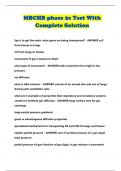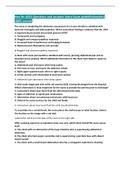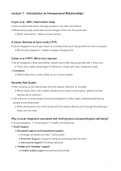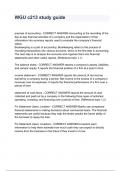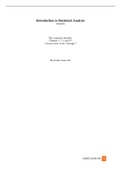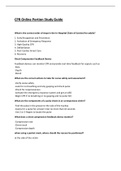Introduction to Engineering Calculations
2.1 Unit conversion
(a)
From Table A.9 (Appendix A): 1 cP = 10–3 kg m–1 s–1
1 m = 100 cm
Therefore:
10−3 kg m −1 s −1 1m
1.5 × 10−6 cP = 1.5 × 10−6 cP . . = 1.5 × 10−11 kg s −1 cm −1
1 cP 100 cm
Answer: 1.5 × 10–11 kg s–1 cm–1
(b)
From Table A.8 (Appendix A): 1 hp (British) = 42.41 Btu min–1
Therefore:
42.41 Btu min −1
0.122 hp = 0.122 hp . = 5.17 Btu min −1
1 hp
Answer: 5.17 Btu min–1
(c)
1 min = 60 s
rpm means revolutions per minute. As revolutions is a non-dimensional quantity (Section 2.1.2), the units
of rpm are min–1. Therefore:
1 min
10,000 min −1 = 10,000 min −1 . = 167 s −1
60 s
Answer: 167 s–1
(d)
From Table A.8 (Appendix A): 1 W = 1 J s–1
From Table A.7 (Appendix A): 1 J = 9.869 × 10–3 l atm
From Table A.1 (Appendix A): 1 m = 3.281 ft
1 min = 60 s
As explained in Section 2.4.6, °C–1 is the same as K–1. Therefore:
2
−2 −1 1 J s −1 9.869 × 10−3 l atm 60 s
−2 −1 1m
4335 W m °C = 4335 W m °C . . . .
1W 1J 1 min 3.281 ft
= 238.45 l atm min −1ft −2 K −1
Answer: 238 l atm min–1 ft–2 K–1
1
, P.M. Doran – Bioprocess Engineering Principles – Solutions Manual
________________________________________________________________________________________________________
2.2 Unit conversion
(a)
From Table A.7 (Appendix A): 1 Btu = 0.2520 kcal
From Table A.3 (Appendix A): 1 lb = 453.6 g
Therefore:
0.2520 kcal 1 lb
345 Btu lb −1 = 345 Btu lb −1 . . = 0.192 kcal g −1
1 Btu 453.6 g
Answer: 0.192 kcal g–1
(b)
From Table A.5 (Appendix A): 1 mmHg = 1.316 × 10–3 atm
From Table A.1 (Appendix A): 1 ft = 0.3048 m
From Table A.7 (Appendix A): 1 l atm = 9.604 × 10–2 Btu
From Table A.8 (Appendix A): 1 Btu min–1 = 2.391 × 10–2 metric horsepower
1 m = 100 cm
1 l = 1000 cm3
1 h = 60 min
Therefore:
3 3
1.316 × 10−3 atm 9.604 × 10−2 Btu 0.3048 m 100 cm
670 mmHg ft 3 = 670 mmHg ft 3 . . . . .
1 mmHg 1 l atm 1 ft 1m
1l 2.391 × 10−2 metric horsepower 1h
3
. −1
.
1000 cm 1 Btu min 60 min
= 9.56 × 10−4 metric horsepower h
Answer: 9.56 × 10–4 metric horsepower h
(c)
From Table A.7 (Appendix A): 1 kcal = 4.187 × 103 J
1 kcal = 1000 cal
1 kg = 1000 g
As explained in Section 2.4.6, °C–1 is the same as K–1. Therefore:
1 kcal 4.187 × 103 J 1000 g
0.554 cal g −1 °C−1 = 0.554 cal g −1 °C −1 . . .
1000 cal 1 kcal 1 kg
= 2319.6 J kg −1 K −1
Answer: 2320 J kg–1 K–1
(d)
From Table A.2 (Appendix A): 1 m3 = 103 l
2
, Chapter 2 – Introduction to Engineering Calculations
________________________________________________________________________________________________________
1 kg = 1000 g
Therefore:
1 kg 103 l
103 g l−1 = 103 g l−1 . . = 103 kg m −3
1000 g 1 m3
Answer: 103 kg m–3
2.3 Unit conversion
(a)
From Table A.2 (Appendix A): 1 m3 = 103 l
1 g = 106 µg
1 l = 1000 ml
Therefore:
1g 1000 ml 103 l
106 µg ml−1 = 106 µg ml−1 . 6
. . 3
= 106 g m −3
10 µg 1l 1m
Answer: 106 g m–3
(b)
From Table A.9 (Appendix A): 1 cP = 10–3 Pa s
1 Pa s = 1000 mPa s
Therefore:
10−3 Pa s 1000 mPa s
3.2 cP = 3.2 cP . . = 3.2 mPa s
1 cP 1 Pa s
Answer: 3.2 mPa s
(c)
From Table A.7 (Appendix A): 1 Btu = 1.055 × 103 J
From Table A.8 (Appendix A): 1 W = 1 J s–1
From Table A.1 (Appendix A): 1 ft = 0.3048 m
1 h = 3600 s
From Section 2.4.6, a temperature difference of 1 K corresponds to a temperature difference of 1.8 °F.
Therefore:
1.055 × 103 J 1h 1 ft
150 Btu h −1 ft −2 (°F ft −1 )−1 = 150 Btu h −1 ft −1 °F−1 . . . .
1 Btu 3600 s 0.3048 m
1.8 °F 1 W
.
1 K 1 J s −1
= 259.6 W m −1 K −1
Answer: 260 W m–1 K–1
3
, P.M. Doran – Bioprocess Engineering Principles – Solutions Manual
________________________________________________________________________________________________________
(d)
1 h = 3600 s
rph means revolutions per hour. As revolutions is a non-dimensional quantity (Section 2.1.2), the units of
rph are h–1. Therefore:
1h
66 rph = 66 h −1 . = 1.83 × 10−2 s −1
3600 s
Answer: 1.83 × 10–2 s–1
2.4 Unit conversion and calculation
Convert to units of kg, m, s.
From Table A.2 (Appendix A): 1 ft3 = 2.832 × 10–2 m3
From Table A.2 (Appendix A): 1 m3 = 103 l
From Table A.3 (Appendix A): 1 lb = 0.4536 kg
From Table A.8 (Appendix A): 1 metric horsepower = 7.355 × 102 kg m2 s–3
From Table A.1 (Appendix A): 1 m = 39.37 in.
Therefore:
1/3
1 m3
10,000 l . 3
65 lb 10 l 1 ft 3 0.4536 kg
tm = 5.9 (2.3 m) 2/3 3 . .
ft 2 2 −3
7.355 × 10 kg m s 2.832 × 10 m−2 3
1 lb
0.70 metric hp .
1 metric hp
1/3
2.3 m 39.37 in.
.
45 in. 1m
= 5.9 (2.3)2/3 m 2/3 (2.724 m −2/3 s) 1.262
= 35.3 s
Answer: 35 s
2.5 Unit conversion and dimensionless numbers
Case 1
Convert to units of kg, m, s.
From Table A.3 (Appendix A): 1 lb = 0.4536 kg
From Table A.2 (Appendix A): 1 ft3 = 2.832 × 10–2 m3
From Table A.9 (Appendix A): 1 cP = 10–3 kg m–1 s–1
1 m = 100 cm = 1000 mm
Using Eq. (2.1):
4

